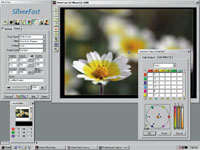LaserSoft's SilverFast 4
I reported on the new Nikon
Super CoolScan 2000 in the February issue with all of its exciting new
features like ImageClean and Multiple Scan Sampling. My enthusiasm was
dampened only slightly by my finding the Nikon software not quite equal
to the rest of the package. In my conclusion I noted I'd be looking
forward to LaserSoft offering a new version of SilverFast for the LS-2000
scanner. Since its release I've now had some time to work with
LaserSoft's SilverFast 4 for the Nikon Super CoolScan 2000. This
new software makes using the LS-2000 scanner a totally new experience
beyond any imagined expectations. |
|||
Probably the most significant
improvement LaserSoft has made to SilverFast from my perspective, having
many images to scan on color negative film, is that the conversion process
is now fully automatic just by selecting "negative" in the
Pos/Neg dialog in the SilverFast Control Panel. Then, when a prescan is
made, the inversion and interpretation of the color negative image values
to positive RGB/ CMYK is accomplished as part of the processing that presents
the preview image on screen. You can then apply image adjustments in the
same manner as you would scanning a positive slide, automatically or manually,
and the final scan will result in image values just as you would expect
from the adjusted appearance in the preview window. |
- Log in or register to post comments



































